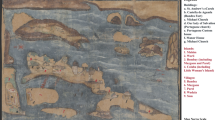Abstract
Rennell has been widely known as the father of the modern maps since the publication of his survey works of 1760s. He made the first nearly accurate map of the then Bengal of the Indian Subcontinent entitled “A Bengal Atlas (1779)”, a work which was considered as the most significant geographical contributions of the British Empire for their strategic and administrative interests. The most important feature of the Atlas is the Ganges Basin which flows as the trans-boundary River of South Asia entrenching India, China and Bangladesh. This study reveals the historical and contextual phenomena of the river like old channels, onomastic and old administrative footprints from Rennell’s Atlas around the old courses of Ganges River, more specifically Plate 18 confining within the territorial extent of current Bangladesh Boundary entrapping the history more than 250 years of the aerial extent encompassing 11,651 km2. This research also reveals the map accuracy by calculating the modern graticules comparing the former geographic coordinate systems. In order to develop historical dataset based on Rennell’s map, various modern tools of renowned GIS approaches and corresponding attributes like geo-referencing, digitizing, geo-corrections, projection transformation, calculating geometry, pivot table etc. In the 1760s, Rennell was dependent on the primitive sextant instrument and calculated latitude, longitude assuming Fort William of Kolkata as Zero (0) degree. In this research we integrated Bangladesh Transverse Mercator (BTM) considering World Geodetic System 1984 as datum. The results illustrate the volume of rivers, riverine forest, jheel, char land are occupying 116,600; 215,959; 3573; and 15,471 ha respectively in the Rennell’s map which are currently almost disappeared. In the said plate, marsh land covered the maximum area about 118,676 ha while length of Kaccha (unmetalled) road was 1339 km, though recently metalled road length has been increased dramatically. The detected broad administrative unit was 337. The error result in the present research is with 99% accuracy. This research has highlighted the strengths to retrieve underlying evidences and relevant features and statistical/attribute data from the historical maps using remote Sensing (RS) and Geographic Information System (GIS) approaches.










Similar content being viewed by others
References
Barrow IJ (2003) Making history, drawing territory: British mapping in India, c.1756- 1905. Oxford University Press, New York
Chaudhary, Sushil (2000) The prelude to empire: Plassey revolution of 1757. Manohar, New Delhi
Fawcus LK (1927) Final report on the Khulna settlement: 1920–1926. Bengal secretariat book depot, Calcutta (189 pp.)
Gulam M (2008) A methodological approach‖, Unpublished BSc research report, Department of Geography and Environment, Jahangirnagar University, Savar, Dhaka
Khorram S, Biging GS, Chrisman NR, Colby DR, Congalton RG, Dobson JE, Ferguson, RL, Goodchild MF, Jensen JR, Mace TH (1999) Accuracy assessment of remote sensing- derived change detection. ASPRS
LaTouche (1910) Rennell, James; Ed. T.H.D. The Journals of Major James Rennell. Calcutta: Baptist Mission Press and Asiatic Society
Markham CR (1878) Memoir on the Indian surveys. Secretary of state for India in council, 2nd edn. W.H. Allen and Co, London
Plewe B (2002) The nature of uncertainty in historical geographic information. Trans GIS 6:431–456
Raghunath P, Padmini P (2018) Remote sensing and GIS-based analysis of evolving planform morphology of the middle-lower part of the Ganga River, India. Egypt J Remote Sens Space Sci. https://doi.org/10.1016/j.ejrs.2018.01.007
Rai PK, Nathawat MS (2017) Applying remote sensing and GIS in study of physical and cultural aspects of Varanasi District, Geoinformatics in Health Facility Analysis. https://doi.org/10.1007/978-3-319-44624-0_2
Rennell J (1779) Atlas of Bengal and Bahar in VIII parts. Act of Parliament, London
Rennell J (1793) Memoir of a Map of Hindoostan or the Mogul Empire (with an introduction,illustrative of the Geography and Present Division of that Country and A map of the countries situated between the heads of the Indian rivers, and the Caspian Sea also a supplementary Map). (Reprinted in 1976. Calcutta: Editions Indian)
Rudra K (2014) Changing river courses in the western part of the ganga Brahmaputra delta. Geomorphology 227:87–100
Sandes (1935) The Military Engineer in India Vol II
Shamsuddin D, Rashid MS (2005) Importance of old map in the Histrical Geographical Research of Bangladesh, vol 24, Bhogol Pottrika
Tarikul MI (2013) Chain and tape survey, page1-14
Tsarouchi GM, Mijic A, Moulds S, Buytaert W (2014) Historical and future land-cover changes in the upper Ganges basin of India. Int J Remote Sens 35(9):3150–3176. https://doi.org/10.1080/01431161.2014.903352
UNESCO (2012) Operational guidelines for the implementation of the world heritage convention. UNESCO world heritage Centre, Paris, p Page14
Author information
Authors and Affiliations
Corresponding author
Additional information
Publisher’s note
Springer Nature remains neutral with regard to jurisdictional claims in published maps and institutional affiliations.
Rights and permissions
About this article
Cite this article
Ety, N.J., Rashid, S. Analysis of historical dataset based on Rennell’s map on Ganges River basin. J Coast Conserv 24, 51 (2020). https://doi.org/10.1007/s11852-020-00767-3
Received:
Revised:
Accepted:
Published:
DOI: https://doi.org/10.1007/s11852-020-00767-3




